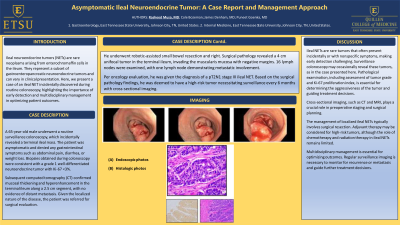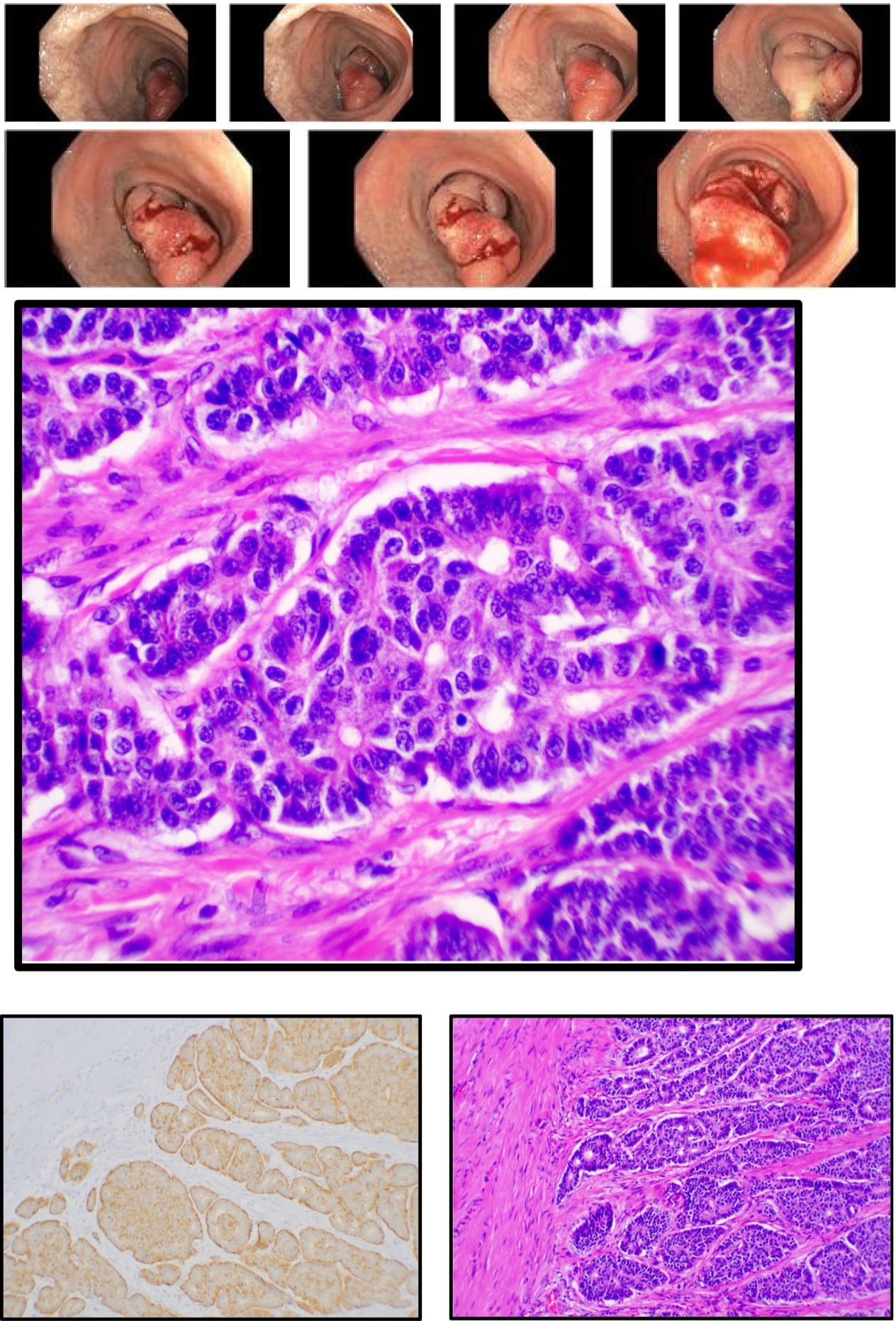Tuesday Poster Session
Category: Small Intestine
P4960 - Asymptomatic Ileal Neuroendocrine Tumor: A Case Report and Management Approach
Tuesday, October 29, 2024
10:30 AM - 4:00 PM ET
Location: Exhibit Hall E

Has Audio

Rasheed Musa, MD
East Tennessee State University
Johnson City, TN
Presenting Author(s)
Rasheed Musa, MD, Parth Goenka, , Cole Bozeman, , James Denham, MD, Puneet Goenka, MD
East Tennessee State University, Johnson City, TN
Introduction: Ileal neuroendocrine tumors (NETs) are rare neoplasms arising from enterochromaffin cells in the ileum. They represent a subset of gastroenteropancreatic neuroendocrine tumors and can vary in clinical presentation. Here, we present a case of an ileal NET incidentally discovered during routine colonoscopy, highlighting the importance of early detection and multidisciplinary management in optimizing patient outcomes.
Case Description/Methods: A 65-year-old male underwent a routine surveillance colonoscopy, which incidentally revealed a terminal ileal mass. The patient was asymptomatic and denied any gastrointestinal symptoms such as abdominal pain, diarrhea, or weight loss. Biopsies obtained during colonoscopy were consistent with a grade 1 well-differentiated neuroendocrine tumor with Ki-67 < 3%.
Subsequent computed tomography (CT) confirmed mucosal thickening and hyperenhancement in the terminal ileum along a 2.5 cm segment, with no evidence of distant metastasis. Given the localized nature of the disease, the patient was referred for surgical evaluation.
He underwent robotic-assisted small bowel resection and right. Surgical pathology revealed a 4 cm unifocal tumor in the terminal ileum, invading the muscularis mucosa with negative margins. 16 lymph nodes were examined, with one lymph node demonstrating metastatic involvement.
Per oncology evaluation, he was given the diagnosis of a pT2N1 stage III ileal NET. Based on the surgical pathology findings, he was deemed to have a high-risk tumor necessitating surveillance every 6 months with cross-sectional imaging.
Discussion: Ileal NETs are rare tumors that often present incidentally or with nonspecific symptoms, making early detection challenging. Surveillance colonoscopy may occasionally reveal these tumors, as in the case presented here. Pathological examination, including assessment of tumor grade and Ki-67 proliferation index, is essential for determining the aggressiveness of the tumor and guiding treatment decisions.
Cross-sectional imaging, such as CT and MRI, plays a crucial role in preoperative staging and surgical planning.
The management of localized ileal NETs typically involves surgical resection. Adjuvant therapy may be considered for high-risk tumors, although the role of chemotherapy and radiation therapy in ileal NETs remains limited.
Multidisciplinary management is essential for optimizing outcomes. Regular surveillance imaging is necessary to monitor for recurrence or metastasis and guide further treatment decisions.

Disclosures:
Rasheed Musa, MD, Parth Goenka, , Cole Bozeman, , James Denham, MD, Puneet Goenka, MD. P4960 - Asymptomatic Ileal Neuroendocrine Tumor: A Case Report and Management Approach, ACG 2024 Annual Scientific Meeting Abstracts. Philadelphia, PA: American College of Gastroenterology.
East Tennessee State University, Johnson City, TN
Introduction: Ileal neuroendocrine tumors (NETs) are rare neoplasms arising from enterochromaffin cells in the ileum. They represent a subset of gastroenteropancreatic neuroendocrine tumors and can vary in clinical presentation. Here, we present a case of an ileal NET incidentally discovered during routine colonoscopy, highlighting the importance of early detection and multidisciplinary management in optimizing patient outcomes.
Case Description/Methods: A 65-year-old male underwent a routine surveillance colonoscopy, which incidentally revealed a terminal ileal mass. The patient was asymptomatic and denied any gastrointestinal symptoms such as abdominal pain, diarrhea, or weight loss. Biopsies obtained during colonoscopy were consistent with a grade 1 well-differentiated neuroendocrine tumor with Ki-67 < 3%.
Subsequent computed tomography (CT) confirmed mucosal thickening and hyperenhancement in the terminal ileum along a 2.5 cm segment, with no evidence of distant metastasis. Given the localized nature of the disease, the patient was referred for surgical evaluation.
He underwent robotic-assisted small bowel resection and right. Surgical pathology revealed a 4 cm unifocal tumor in the terminal ileum, invading the muscularis mucosa with negative margins. 16 lymph nodes were examined, with one lymph node demonstrating metastatic involvement.
Per oncology evaluation, he was given the diagnosis of a pT2N1 stage III ileal NET. Based on the surgical pathology findings, he was deemed to have a high-risk tumor necessitating surveillance every 6 months with cross-sectional imaging.
Discussion: Ileal NETs are rare tumors that often present incidentally or with nonspecific symptoms, making early detection challenging. Surveillance colonoscopy may occasionally reveal these tumors, as in the case presented here. Pathological examination, including assessment of tumor grade and Ki-67 proliferation index, is essential for determining the aggressiveness of the tumor and guiding treatment decisions.
Cross-sectional imaging, such as CT and MRI, plays a crucial role in preoperative staging and surgical planning.
The management of localized ileal NETs typically involves surgical resection. Adjuvant therapy may be considered for high-risk tumors, although the role of chemotherapy and radiation therapy in ileal NETs remains limited.
Multidisciplinary management is essential for optimizing outcomes. Regular surveillance imaging is necessary to monitor for recurrence or metastasis and guide further treatment decisions.

Figure: Ileal NET endo and histo
Disclosures:
Rasheed Musa indicated no relevant financial relationships.
Parth Goenka indicated no relevant financial relationships.
Cole Bozeman indicated no relevant financial relationships.
James Denham indicated no relevant financial relationships.
Puneet Goenka indicated no relevant financial relationships.
Rasheed Musa, MD, Parth Goenka, , Cole Bozeman, , James Denham, MD, Puneet Goenka, MD. P4960 - Asymptomatic Ileal Neuroendocrine Tumor: A Case Report and Management Approach, ACG 2024 Annual Scientific Meeting Abstracts. Philadelphia, PA: American College of Gastroenterology.
